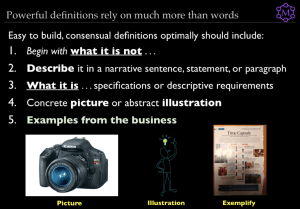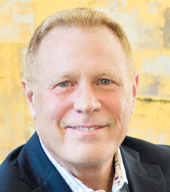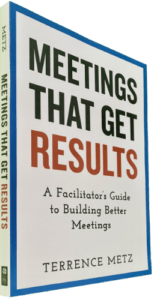To build an operational and consensual definition that your group can live with, in their own words, and with their understanding, use the following Definition tool. Since narrative descriptions alone may fall short of expressing the complete meaning, we also want to fortify the consensual definition with an illustration and examples.
Use this robust method for consensual definitions of terms, phrases, or expressions with a group of meeting or workshop participants. Keep in mind that the standards expected below are demanding. They include five effective activities. Keep this tool in your hip pocket and use it whenever you encounter serious discord over the meaning of something. You may also need this tool when you manage open issues (i.e., Parking Lot) and your participants do not agree or cannot remember what something meant.
Additionally, the analysis activity of brainstorming begins when the ideation energy begins to wane. An indicator that it may be time to transition to analysis could be a question raised about what a term means, or someone raising an argumentative point that something can or cannot satisfy a specified condition or requirement.
Session leaders are faced with groups and participants (who may be in violent agreement with each other) who need to develop a consensual understanding of what a particular term, phrase, or expression means. The most underutilized tool in the sphere of facilitation is a robust definition tool. Therefore the first step frequently required to support effective analysis requires properly defining something.
Purpose of Consensual Definitions
To build a consensual definition of a term or phrase that the group can live with, in its own words, and with its own understanding. Since narrative descriptions alone may fall short, support your consensual definition with an illustration and examples.
Rationale Behind Consensual Definitions

Consensual Tool for Definitions
This MGRUSH tool supports a consensual understanding of terms and phrases. Use something more robust to develop rich definitions for complex ideas like processes. Hence, for an entire workshop(s) Activity Flows may be more useful.
Method to Build Consensual Definitions
When a term or phrase requires further definition or understanding, it may be best to compare it to a dictionary definition(s). However, do not begin with dictionary definitions. Rather, offer them as a stimulus for the group after drafting their own definition. The five additional activities include:
- First, identify “WHAT THE TERM OR PHRASE IS NOT”.
- Next, compile a narrative sentence or paragraph that generally describes it. Compare later to a dictionary or other professional definitions and support.
- Then list the detailed bullets that capture the specific characteristics or specifications of the term or phrase as intended by the participants. For example, with a camera, we might detail requirements for the number of megapixels, zoom range, etc.
- Obtain or build a picture of concrete items or create an illustration of the item if it is abstract or dynamic (e.g., process flow).
- Provide at least two actual, real-life examples from the participants’ experience that vivify the term or phrase. For example, a utility bill can be defined, but it is helpful to show an actual invoice (e.g., electricity for the period 15JAN20xx to 14FEB20xx).
______
Don’t ruin your career by hosting bad meetings. Sign up for a workshop or send this to someone who should. MGRUSH workshops focus on meeting design and practice. Each person practices tools, methods, and activities every day during the week. Therefore, while some call this immersion, we call it the road to building high-value facilitation skills.
Our workshops also provide a superb way to earn up to 40 SEUs from the Scrum Alliance, 40 CDUs from IIBA, 40 Continuous Learning Points (CLPs) based on Federal Acquisition Certification Continuous Professional Learning Requirements using Training and Education activities, 40 Professional Development Units (PDUs) from SAVE International, as well as 4.0 CEUs for other professions. (See workshop and Reference Manual descriptions for details.)
Want a free 10-minute break timer? Sign up for our once-monthly newsletter HERE and receive a timer along with four other of our favorite facilitation tools, free.

Terrence Metz, president of MG RUSH Facilitation Training, was just 22-years-old and working as a Sales Engineer at Honeywell when he recognized a widespread problem—most meetings were ineffective and poorly led, wasting both time and company resources. However, he also observed meetings that worked. What set them apart? A well-prepared leader who structured the session to ensure participants contributed meaningfully and achieved clear outcomes.
Throughout his career, Metz, who earned an MBA from Kellogg (Northwestern University) experienced and also trained in various facilitation techniques. In 2004, he purchased MG RUSH where he shifted his focus toward improving established meeting designs and building a curriculum that would teach others how to lead, facilitate, and structure meetings that drive results. His expertise in training world-class facilitators led to the 2020 publication of Meetings That Get Results: A Guide to Building Better Meetings, a comprehensive resource on effectively building consensus.
Grounded in the principle that “nobody is smarter than everybody,” the book details the why, what, and how of building consensus when making decisions, planning, and solving problems. Along with a Participant’s Guide and supplemental workshops, it supports learning from foundational awareness to professional certification.
Metz’s first book, Change or Die: A Business Process Improvement Manual, tackled the challenges of process optimization. His upcoming book, Catalyst: Facilitating Innovation, focuses on meetings and workshops that don’t simply end when time runs out but conclude with actionable next steps and clear assignments—ensuring progress beyond discussions and ideas.




Facilitator: As the name implies, the role of the facilitator is to help make the process of reaching a consensus decision easier. Facilitators accept responsibility for moving through the agenda on time; ensuring the group adheres to the mutually agreed-upon mechanics of the consensus process; and, if necessary, suggesting alternate or additional discussion or decision-making techniques, such as go-arounds, break-out groups or role-playing.
Well stated Mix-Movie. Hope others gain the same clarity of thought and understanding.